More on airport-related transit/transit for visitors
I wrote about this last week, "Night moves: the need for more night time (and weekend) transit service, especially when the subway is closed."
But then, Mobility Lab ran an entry, "Active Transportation Information Needed at Event-Planning Websites," on how meeting planners could better integrate transit-related information into their conference websites. And today's Examiner has a piece, "Loudoun County wants surcharge at Washington Dulles International Airport's Silver Line station," where a Loudoun County Supervisor recommends that a surcharge be added to subway fares getting on/off the stop for Dulles Airport, and whether or not such a surcharge should be added to National Airport as well.
From the Examiner article:
Metro riders who use the Silver Line's future stop at Washington Dulles International Airport may have to pay an extra surcharge on top of their regular fare if Loudoun County officials get their way.
It's unfair that Loudoun alone will have to pay for the upkeep of the airport stop, since so many D.C.-bound travelers will be using the station, Loudoun Supervisor Matt Letourneau said at a meeting of regional leaders Wednesday.
"It's a continuing source of frustration to Loudoun that we'll be paying the operating costs at the airport station," he said. "It didn't seem all that logical that Loudoun County be on the hook for that because most people who are going to board at Dulles airport are going east. They're going into D.C., not to the two stations in Loudoun."
And Dr. Gridlock in the Post ran a question where a writer suggests that WMATA have more multi-day parking spots at Metro stations to support people taking transit to airports.
Plus, while I haven't had a chance to explore it, I've just come across an incredibly robust visitor information center best practice research project in Queensland, Australia, which can be mined for innovation as well. And Destination Melbourne's new focus on visitability, including a focus on "access and transport" issues for visitors.
1. Airport Transit Fare Surcharge. The San Francisco Airport does have a $3 surcharge for fares to and from the Airport. See "BART considers waiving airport surcharge for SFO-based workers" from the San Francisco Examiner.
It's used to help pay for the cost of building the subway extension. I don't necessarily have a problem with this, but it can be onerous, especially for employees--note that the proposal in San Francisco to eliminate the surcharge for workers doesn't really eliminate it. The Airport actually would pay the amount to BART separately.
WMATA already charges a big surcharge to take a bus to the BWI and Dulles Airports now (the fare is $6), treating it as a premium service. I haven't ridden the bus to Dulles for a long time so I don't know what the story is there, but the bus to B30 is outfitted specially with luggage racks, which makes handling a bunch of luggage pretty easily, compared to most other places.
And related to last week's entry, I'd be okay with a late night surcharge for nite owl bus service from National Airport, if that meant having access to such a service.
2. Charging visitors higher transit fares more generally. Note that one way that transit systems charge visitors a lot more is by discounting fares for smartcard holders. Some people then just buy the cards, knowing they get discounts. But probably most people don't know.
For example, in the WMATA system, fares using paper transit cards on the subway are $1 more than the cost of the same trip with a smartcard.
This is a tough issue generally, because you want to encourage people to use transit instead of drive, especially as when people drive in unfamiliar places, they can contribute to congestion in extranormal ways.
3. Long-term parking at Metro sites to serve people going to the airport. It's probably a bad idea for WMATA to tie up spaces at stations for parking, especially for spaces that don't turn over for days at a time. It's better for there to be buses and such to take people to stations, along the lines of intra-neighborhood transit services that I champion in other entries. This needs further research.
4. Conference planning/transit information. Yes, conferences should be more diligent in providing information on transit options. Transit and urbanism conferences often get local sponsorships from the transit authority, which can include free transit passes or other inducements. For example, at the 2012 Rail-volution conference in DC, Maryland's MTA was a sponsor, and attendees received a $10 CharmCard for the MTA system, not realizing probably that the CharmCard functions the same as the DC area SmarTrip card, just with a different brand.
But it can be hit or miss with Convention and Visitors Bureaus to promote transit to conference planners in a systematic way. So they need to work with local transit authorities to up their game on this dimension.
Years ago, pre all the mobile apps for transit in the social media/mobile phone world, I suggested (not sure if I blogged about it) that transit agencies create widgets for their trip planners that could be integrated into other websites. Such a widget could be incorporated into a conference meeting website, to promote transit.
Some airports are developing mobile apps to assist people in getting around the airport ("Are You Ready for the Airport Webolution?" from Airport Improvement Magazine), "Creative Innovations - Technology: 1st Place | DFW Airport Mobile Application,DFW International Airport" from Airports Council International).
Transit agencies need to think similarly. (And rather than the relative chaos of all the various agencies and motivated app developers doing their own thing, I wish that agencies would have banded together via the American Public Transportation Association to create a set of standard apps.)
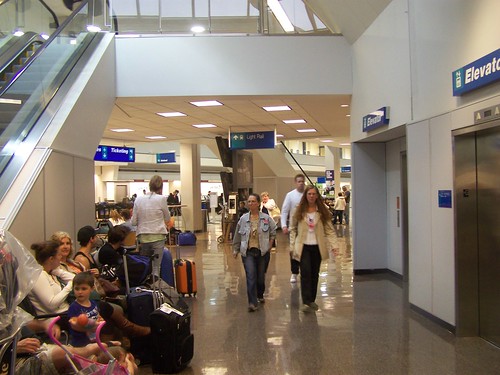 Right: Light rail sign at Salt Lake City International Airport.
Right: Light rail sign at Salt Lake City International Airport.5. Transit information at airports generally can be much better than it usually is. A couple weeks ago, I went to the Congress for the New Urbanism annual meeting in Salt Lake City.
SLC built a huge airport to support the 2002 Winter Olympics (which is why I don't understand why they need to spend even more money now to expand and upgrade the airport). The Olympics was also the justification for funding their light rail system. (Not unlike how Barcelona and Vancouver and London expanded transit and other infrastructure in association with mounting the Olympics.)
It's pretty easy to get downtown via the light rail in Salt Lake City, just as it is easy to get to DC from National Airport via the subway--when the subway is running. But even so, some of the urbanists I knew took taxis.
And if you have a lot of luggage, face it, riding transit can be very grueling.
But for the most part, the provision of information within the Salt Lake City Airport for transit/light rail was pretty paltry, other than there being signs.
I think of people who use transit regularly as "already trained" in how to use transit. Because it functions pretty similarly everywhere, if you know how to use buses and rail in one place, you can figure out how to do it someplace else.
In the US, something like 4% of total trips are made by transit. So most people, especially from upper income demographics typifying airplane travel, are unfamiliar with transit, unless they are from those handful of communities that have widespread transit networks (like the DC area, or Philadelphia or NYC or Boston or Chicago, etc.).
This is a huge "market development" problem as it relates to transit use for infrequent riders, especially travelers.
6. Transit information provision at the Seattle and Portland Airports is best practice (or at least it was in 2007 and 2005 respectively). It happens that I wrote a long blog entry on this topic in 2007, "To get people who have mobility choices to choose transit, they have to know it exists." And yes, I am taking the liberty of reprinting the entry below.
The stuff about Seattle is a bit out of date because a couple years ago, light rail service started running from the Airport to Downtown Seattle. Later this summer, I'll see how they might have updated their provision of transit information in response.

Trying to get on the subway at National Airport. Flickr photo by Burnt Pixel.
1. You don't necessarily appreciate the convenience of WMATA, the Washington area subway and bus system, until you ride transit in other places. (Not that there aren't many aspects of transit that can't be improved -- see below.) Subway to National Airport is so much easier than bus to/from other airports.
At least WMATA, in its services to Dulles Airport and BWI Airport, has a special bus, with racks to accommodate luggage. The bus service to the Seattle-Tacoma Airport is extensive, both by the King County system (Seattle) and Sound Transit (Tacoma). But they are regular buses, with no special accommodations for luggage.
And it is a pain in the a** to lug three bags and stuff them in and around your seat on a full--articulated, which can accommodate 60-80 people--bus.
 The same goes for Pittsburgh and its 28X bus service. The Pittsburgh buses are regular, either mini or full sized, buses without special accommodations for luggage. Sign for the Pittsburgh Airport bus service pictured at right.
The same goes for Pittsburgh and its 28X bus service. The Pittsburgh buses are regular, either mini or full sized, buses without special accommodations for luggage. Sign for the Pittsburgh Airport bus service pictured at right.However, more people ride the bus to Seattle from the airport, even though the usage for the Pittsburgh bus is high, so comparatively it's easier to take luggage to/from the Pittsburgh airport compared to Seattle.
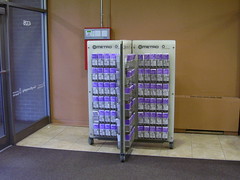
Still one thing that I don't think WMATA (or DC for that matter) does very well is use transit points of purchase (bus stops, subway stations) and frequently used places as points to promote and distribute information about transit.
Left: Transit Information Rack, University Book Store, University of Washington, Seattle
I mention this because I didn't go to many places yesterday--the airport, Pike Place Market, and the University District adjacent to the University of Washington--but I found in each place a massive rack distributing information about public transit (which in this region includes ferry service)--at the University of Washington, it was at the student bookstore (I didn't go deeper into the campus, say to the Union or Library to see if there is similar information posted there; I do remember Portland having such a rack at the central library for Portland State University).
Plus, the buses had information displayed as well, including the Sound Transit published Transit Guide.
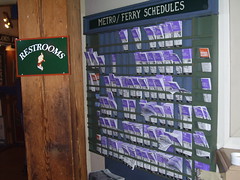
Right: Transit schedule information, Pike Place Market.
3. By way of comparison, at National Airport in Terminal A, there are two transit brochures, one the schedule for the 5A bus line to Dulles Airport and another general brochure (but no maps or other promotional materials displayed) in an information rack affixed to an information booth.. Granted there is the subway station, which is a promotion in and of itself, but I write frequently that we need to better utilize these stations as places to promote transit.
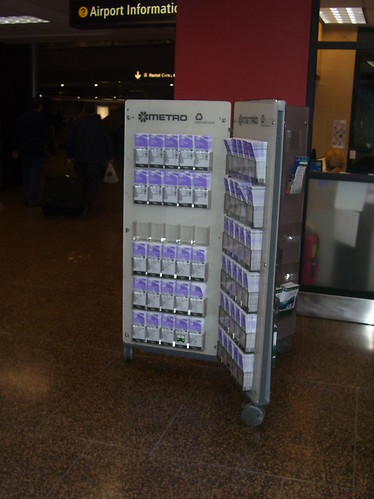
Pictured at right, at the Seattle-Tacoma airport, a large information rack for public transit was immediately adjacent to the Visitor Information desk.
I think information about transit was also placed in the various visitor information racks too. Plus the signage pointing people to the public transit ground transportation options was also pretty clear.
Plus, this poster, promoting transit as a viable way to get around, was affixed to one of the boards in the six-sided information rack.

And the signage at the bus stop explained how to use the system very well, and how to get to various places in the region from the airport, using public transit.
This reminds me of my first experience using the subway at National Airport about 20 years ago.
I was new to the city and someone asked me how to get to Germantown by transit. I had no idea. And looking at the map of the subway system even today, how would you know you can get to Germantown by taking the red line to Shady Grove?
These transit-promotion materials were available in the various information racks I have come across so far in Seattle. (I know that some of these kinds of guides are made available by WMATA, or the county-based bus systems. But I don't think there are many such comprehensive guides for the DC region. And these kinds of materials are likely inadequately distributed in our region.)
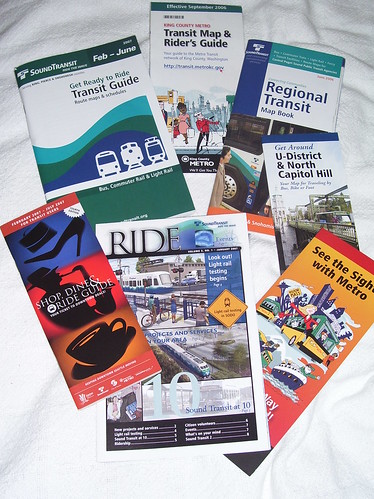
Bus stop/transit information sign, Seattle-Tacoma International Airport
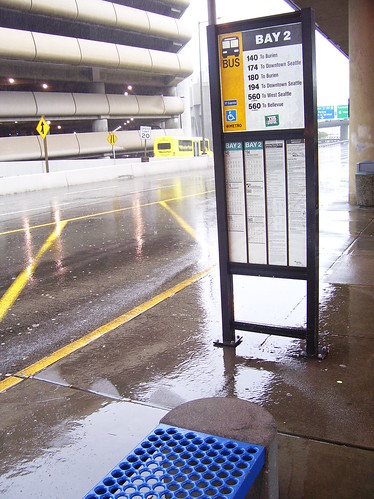
Labels: airports, tourism, transportation planning, visitor services




7 Comments:
I agree completely that only those trained or committed to use transit will use transit at a lot of US airports, especially given the lack of information about transit service greeting arrivals at most airports. Great examples are Denver and Montreal, which both have fairly regular bus service from the airport to downtown. I used both only because I had taken time beforehand to research the service, most notably finding out where to buy tickets, where to catch the bus and the specific location the service takes you. Indeed, the ticket buying at both airports is designed as if it is some kind of treasure hunt or similar competition, with only the most intrepid rewarded with a ticket. Even airports with rail service do not always do a great job of directing arrivals to the service. (I'm talking to you O'Hare Airport.) My colleagues at conferences are often surprised to learn that I took transit from the airport. But you can hardly blame most people for taking a taxi given the lack of information about transit service at so many airports.
haven't been to Denver. Yes, was lucky that the 747 was recently introduced, just before we went to Montreal. Ticket buying sucked.
Note that on our way out of Montreal, we got surveyed by an interviewer about whether or not we would take a train from the Airport to Downtown...
I don't think O'Hare is that bad, but you're probably more right than me, that it works great for people who understand transit. Not so great for people who don't.
Midway sucks in terms of how long a walk it is from the station to the terminal. I should have used a luggage cart.
Agree with you on O'Hare -- it is not really that difficult, but I try to think about it from the perspective of people who might ride transit but are not necessarily committed to it.
I was too busy with work to comment on your series of posts on Salt Lake City, but having spent a good deal of time there, I really enjoyed them. It surprises me that people are surprised that Salt Lake City is progressive on social and transportation issues. But then again, most people don't spend a lot of time thinking about Salt Lake City...
there are some more I should still try to write, at least one about the Community Writing Center...
+ an update on the chickens that I wrote about for what I called "block supported agriculture"
http://www.flickr.com/photos/rllayman/8944401840/in/photostream/
Many travellers and passengers come airport to drop off so they like to park their car at the airport for short stay and they need
cheap airport parking for their cars.
Long stay parking at Metro sites looks pretty good for travellers to park their cars and move ahead for their journey.
meet and greet Luton
Thank you for providing such valuable information and thanks for sharing this Business Promotion technique.click it...: online viagra
Post a Comment
<< Home